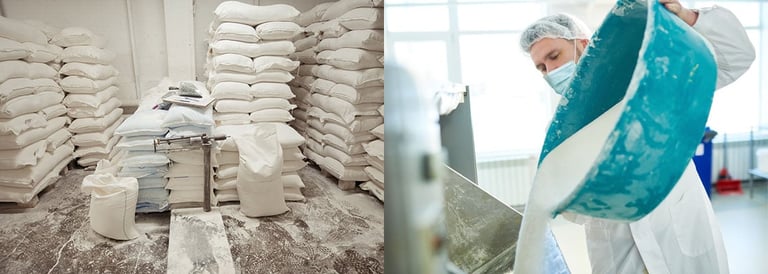- News
- Respiratory Hazards and How to eliminate them
Respiratory hazards in the Food industry and how to eliminate them

Respiratory illnesses are common among employees in the food processing industry. With allergies, asthma, and other conditions becoming more frequent, processors need to implement changes.
In 2016, respiratory illnesses accounted for about 2.5 percent of the total recordable illness distribution in the US food manufacturing industry. Better work practices and respiratory protection can reduce these risks, but ideally, production lines need to be redesigned with particular emphasis on the conveying systems used in the process.
There are plenty of hazardous materials used in the food production line. Pesticides and fumigants are some of the more obvious irritant and allergenic materials that can cause destruction and scarring of the lungs. However, there are many other materials that must be kept under strict control as they affect the respiratory system and can cause long-term negative health effects.
Food dust linked to asthma and allergies
Up to 25% of all asthma cases are related to work. Occupational asthma is the most common occupational lung disease in industrialised countries, while occupational rhinitis is even more frequent. It is estimated that 10-25% of all these respiratory illnesses are caused by inhalation of food-derived materials during food processing.
Many such workplaces rely on processes where dust particles are inhaled which cause allergic or irritant reactions. Particles measuring 10-30 μm in diameter are usually trapped in the upper respiratory tract, where they can evoke irritant or allergic reactions, whereas smaller particles of 5-10 μm diameter can cause asthmatic reactions.
Ordinary, seemingly harmless ingredients, such as for instance, cereal flour of wheat or rye are in fact potent allergic sensitizers. When someone is exposed to aerosols of flour, fungal α-amylase, green coffee, castor bean, or seafood, they run a significant risk of developing work-related asthma, sometimes referred to as baker’s asthma. Food allergies can also be triggered by the inhaled dust or aerosols.
Repeated, long-term exposure can lead to lung diseases. It matters how much dust is inhaled, so it is important to follow recommendations about the maximum amount of time spent on a production line. Farming, milling, bread and pastry making, cereal handling, and grain cleaning and packaging are considered as high-risk occupational activities.
Artificial flavourings linked to bronchitis
Bronchiolitis obliterans is another potentially disabling lung disease which has been identified in operators exposed to food flavourings. Diacetyl is a predominant chemical used in butter flavouring in the microwave popcorn industry. Exposure to as little as 0.02 parts per million has been linked to the occurrence of the disease in workers mixing butter flavourings with heated oil.
The disease also occurs in workers exposed to other artificial flavourings on whole-bean and ground roasted coffee production lines. In 2016, a series of recommendations were made for food manufacturers to measure levels of diacetyl and other gases such as 2,3-pentanedione, and to reduce the risks by imposing effective work practice and engineering controls.
Monitoring might be a good option when exposure is inevitable – but prevention would be the ideal solution. Keeping exposure as low as possible is the best practice available.
Automation reduces the risk of respiratory illnesses
Dust forms when flour or other materials are poured into various equipment, like mixers and agitators. This step is often performed manually by operators lifting bags and pouring out the contents, causing significant amounts of dust to escape to the approximate environment. Flour metering (measuring the right amount to be added to a dough) is often done this way. However, it can so easily be automated.
In the case of flour or other cereal powders, vacuum conveying offers an easy and hygienic solution. The powders can be transported in an enclosed tube to the mixer or blender via sieves. Piab vacuum conveyors are optimized to replace manual feeding of these pieces of equipment or other options, such as lifting and pouring solutions. Materials can be picked up from a barrel, drum or sack which not only prevents dusting, but also contributes to a more ergonomic workplace.
Feeding of seasoning and sprinkling units can also be solved with Piab’s conveyors, together with the feeding of sieving units. These are important steps in reducing the exposure of workers to dust and thus allergens, which is crucial from an employee health and safety perspective and it is also important to ensure the required quality of the product.
Allergens can also get into the air when raw materials and spills occur in the process. By using vacuum conveying at the beginning of the process, the number of spills can be reduced. In addition, the reclaim of spilled raw materials or products can be automatically handled by vacuum conveying. Damaged products can be redirected to scrap or still usable raw materials can be fed back to the beginning of the process.